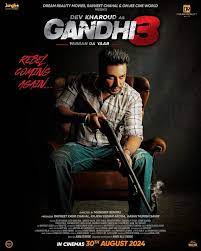Gandhi 3, the third installment in the acclaimed series, emerges as a daring and thought-provoking exploration of the legacy of Mahatma Gandhi in contemporary India. Directed by an emerging filmmaker, the film takes a bold step forward by not only revisiting the iconic historical figure but also presenting an alternate vision of his philosophies in the context of today’s India. With a rich narrative, compelling performances, and a deep exploration of social issues, Gandhi 3 succeeds in sparking meaningful discussions on the relevance of non-violence in a world increasingly divided by conflict.
The movie begins in the present day, with a post-independence India struggling with new challenges, such as growing religious intolerance, political fragmentation, and the rise of nationalism. The protagonist, a modern-day descendant of Gandhi, is depicted as someone caught between honoring his grandfather’s peaceful ideals and navigating a world where violence and aggression often seem to dominate the political landscape. This contemporary perspective offers an intriguing contrast to Gandhi’s ideals, highlighting the ongoing struggle to balance tradition with modernity.
At its core, Gandhi 3 asks the question: Can the values of non-violence and peaceful resistance still hold power in today’s divisive world? The film explores this through its central narrative, where the protagonist, after a series of violent political clashes, is forced to confront the stark contrast between the Gandhi his family speaks of and the chaotic world around him. The film is peppered with flashbacks to key moments in Gandhi’s life, using them as reference points for the protagonist’s personal journey.
The film’s direction is commendable, as it presents a story that is both intimate and grand in scope. The cinematography beautifully contrasts the tranquil, philosophical teachings of Gandhi with the stark, often brutal realities of the modern world. The director makes clever use of visual symbolism, depicting Gandhi’s spinning wheel, his salt march, and other iconic images of his life, but in settings that force the viewer to reimagine their meanings in the context of today’s issues.
The performances in Gandhi 3 are nothing short of impressive. The lead actor delivers a nuanced portrayal of a young man grappling with his inheritance. His internal conflict is palpable, and the film succeeds in making Gandhi’s abstract ideals feel personal and urgent. The supporting cast also shines, with standout performances from veteran actors who lend gravitas to the historical flashbacks. Their portrayal of Gandhi’s contemporaries, such as Jawaharlal Nehru and Sardar Patel, adds a layer of authenticity to the historical narrative.
While the film’s message is undeniably powerful, it does fall into occasional clichés, particularly when dealing with the violence that pervades modern politics. Some sequences feel repetitive, and the film could have delved deeper into the practical aspects of non-violent resistance in the face of overwhelming opposition. Despite these minor flaws, Gandhi 3 succeeds in being a timely and important film that provokes reflection on how the world can reconcile Gandhi’s teachings with the challenges of the present.
In conclusion, Gandhi 3 is a bold and thought-provoking cinematic exploration that successfully revives the relevance of Mahatma Gandhi’s philosophy in a contemporary setting. With its engaging storyline, powerful performances, and timely message, the film serves as both a tribute to Gandhi’s enduring legacy and a call to action for those who believe in the power of peace in a world teetering on the edge of discord.

